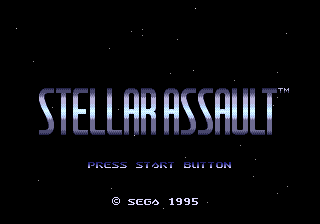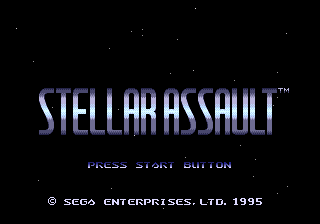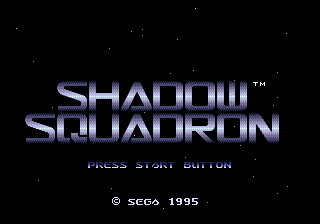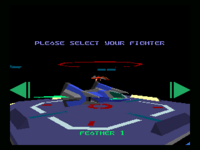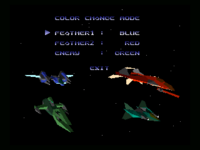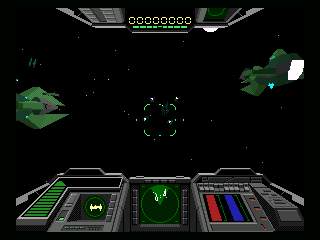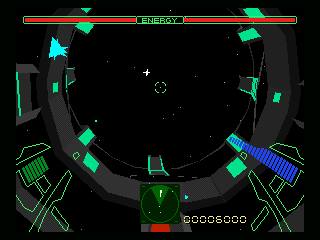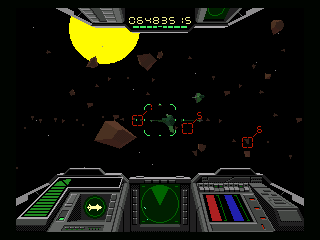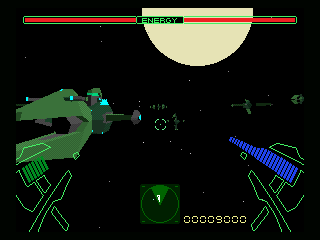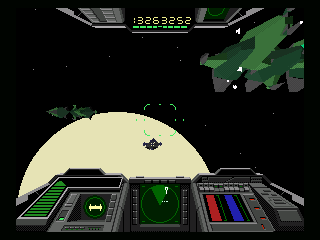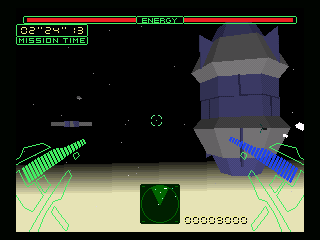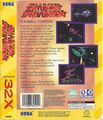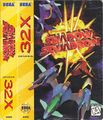Stellar Assault
From Sega Retro
| |||||||||||||||||||||||||||||||||||
| Stellar Assault | |||||||||||||||||||||||||||||||||||
|---|---|---|---|---|---|---|---|---|---|---|---|---|---|---|---|---|---|---|---|---|---|---|---|---|---|---|---|---|---|---|---|---|---|---|---|
| System(s): Sega 32X | |||||||||||||||||||||||||||||||||||
| Publisher: Sega | |||||||||||||||||||||||||||||||||||
| Developer: Sega CS3[1] | |||||||||||||||||||||||||||||||||||
| Sound driver: SMPS 68000 | |||||||||||||||||||||||||||||||||||
| Peripherals supported: Six Button Control Pad | |||||||||||||||||||||||||||||||||||
| Genre: Shooting[2][3] | |||||||||||||||||||||||||||||||||||
| Number of players: 1-2 | |||||||||||||||||||||||||||||||||||
|
Stellar Assault (ステラアサルト), known in the United States as Shadow Squadron, is a Sega 32X space combat simulator game developed by Sega CS and published by Sega. First released in Japan in April 1995, it was later localized and brought to the United States and Europe the following June.
In February 1998, the game received an enhanced port to the Sega Saturn, Stellar Assault SS, courtesy of developer SIMS.
Contents
Story
A coup d'état has occurred in the colonial star system of Sivos (シヴォス). The Rebel Army (反乱軍) quickly overwhelmed the star system with its military might and demanded the surrender of the Allied Forces (連合軍). When the Allied Forces refused, the Rebel Army used a powerful weapon called the Accelerator Gate (アクセルゲート) to bombard Laderia (惑星ラーデリア), the capital planet of the Allied Forces, with meteors. The remnants of the Allied Forces fleet must use its top secret Feather (フェザー) fighters to repel the rebel forces and destroy their Sun-powered Laser Cannon.
Gameplay
The game is a 3D space combat simulation similar to Star Wars Arcade. Players take control of either one of the two Feather fighter ships through six missions set across various sectors in outer space. Each of the two available spacecraft have their advantages and disadvantages: the Feather 1 is a highly maneuverable and fast light ship equipped with guided laser cannons, whereas the Feather 2 is a more powerful and heavier ship that relies on manual fire. Choosing the Feather 2 gives the player the option of enabling auto-pilot, which allows the computer to fly and the player to concentrate on shooting, though the computer pilot generally takes indirect paths through the missions and prolongs the length of the game. The Feather 2 can also be used in cooperative two-player games, with player one flying and player two shooting.
With the exception of some graphical effects such as explosions, the world is rendered entirely as flat-shaded 3D polygons. There are two types of enemies: fighters and carrier ships. Some missions requiring destroying both types of enemies, while others only the carrier ships must be eliminated. Before starting each mission, a tactical display shows the player's ship and all targets that must be eliminated. Both ships have circular radars that show the locations of nearby enemies during gameplay.
The player can control the tilt of the ship and fly in any direction. The ship banks with ![]() and
and ![]() . The vertical controls are inverted, so
. The vertical controls are inverted, so ![]() ascends and
ascends and ![]() dives. The ships roll counterclockwise with
dives. The ships roll counterclockwise with ![]() and clockwise with
and clockwise with ![]() . The ships accelerate with
. The ships accelerate with ![]() or decelerate with
or decelerate with ![]() . The current speed of travel is shown as a green gauge. There are two Speed Control options available in the game options. The first method slows the ship down gradually when the accelerate button is not held down, while the second method maintains the ship's speed until the player changes it by accelerating or decelerating. Both ships are armed with laser guns, which are fired with
. The current speed of travel is shown as a green gauge. There are two Speed Control options available in the game options. The first method slows the ship down gradually when the accelerate button is not held down, while the second method maintains the ship's speed until the player changes it by accelerating or decelerating. Both ships are armed with laser guns, which are fired with ![]() . The player can switch between a first-person, in-cockpit view and a third-person, behind the ship view with MODE .
. The player can switch between a first-person, in-cockpit view and a third-person, behind the ship view with MODE .
When using a standard three-button control pad, the ships roll counterclockwise with HOLD START ![]() and clockwise with HOLD START
and clockwise with HOLD START ![]() . They accelerate with
. They accelerate with ![]() and decelerate with START +
and decelerate with START +![]() . The game can be paused with HOLD START
. The game can be paused with HOLD START ![]() +
+![]() +
+![]() .
.
The ships have two types of energy: weapon/engine energy (red gauge) and shield energy (blue gauge). Weapon/engine energy is expended whenever the ships fire their weapons or engage their thrusters by accelerating. Shield energy represents the ship's protective shield; if it is depleted, the ship cannot sustain any more damage without being destroyed. If the ship runs out of weapon/engine energy, all of its shield energy reserves are transferred to weapon/engine energy, meaning that the next hit destroys the ship. The Feather 1 docks after each mission to replenish its weapon/engine energy and shield energy. The Feather 2 only replenishes its shield energy after each mission, so the player must manage its weapon/engine energy carefully since they must last the entire game.
If the ship is destroyed, players can continue a limited number of times. After the game ends, a Trace option is unlocked at the title screen, which replays the previous playthrough from a third-person perspective.
There are two difficulty levels (Easy and Hard). The game includes options to view the models used in the game or change the colors of the ships.
Ships
| Feather 1 | |
|---|---|
| The Feather 1 is a light fighter. It is weaker than the Feather 2, but it is agile and easy to maneuver, and its weapons are easier to aim.
It is armed with twin laser guns. They are semi-guided, so they home in on any targets within the targeting reticle. The laser guns are fired with It is also armed with guided laser torpedoes. These can be fired by pressing The ship is equipped with a Spectral Shield, activated by holding The Feather 1 has its weapon/engine energy and its shield energy replenished after every mission. | |
| Feather 2 | |
| The Feather 2 is a heavy fighter. It is stronger than the Feather 1, but it moves more sluggishly, and its weapons must be manually aimed. It is the only craft available in two-player games, with player one flying and player two shooting. In single-player games, the player can choose auto-pilot mode, where the computer flies the ship while the player shoots.
It fires a single large laser with Because the Feather 2 only replenishes its shield energy after each mission, it starts with a large reserve of weapon/engine energy. This energy must last the entire game, so players should conserve it as much as possible. |
Missions
The missions incrementally move closer to the Sun in the middle of the solar system.
| Graduation Day | |
|---|---|
| Destroy the two Delmmer carriers and all enemy fighters. | |
| No Admittance | |
| Destroy the Delmmer carrier, two Balsark carriers, and Accelerator Gate in the center of the sector. | |
| Dodge 'Em | |
| Set in an asteroid field. Destroy the two Delmmer carriers, small "booster" ships, and all enemy fighters. | |
| Armada | |
| Destroy all ten carriers, a fleet of Delmmer, Balsark, Medelus, and Carvelus carriers. | |
| Ganeluza Grandslam | |
| Destroy the two Carvelus flagships and the massive Ganeluza carrier. | |
| G.L. Cannon | |
| Destroy the Laser Cannon in the center of the sector, which is surrounded by a ring of "slave units" and defended by a sortie of fighters. This mission has a time limit. |
History
Development
During development, Stellar Assault was known by the name Bullet Fighters.
The game averages at around a 20 FPS refresh rate, although palette cycling occurs at 60 FPS. Some of the performance gains (and the use of a wider colour palette than most 32X titles) can be attributed to the game's decision to use a 288x224 screen resolution (with extra borders).
Versions
Localised names
| Language | Localised Name | English Translation |
|---|---|---|
| English | Stellar Assault | Stellar Assault |
| English (US) | Shadow Squadron | Shadow Squadron |
| Japanese | ステラアサルト | Stellar Assault |
Production credits
- Main article: Stellar Assault/Production credits.
Magazine articles
- Main article: Stellar Assault/Magazine articles.
Promotional material
Artwork
Physical scans
| Sega Retro Average | ||||||||||||||||||||||||||||||||||||||||||||||||||||||||||||||||||||||||||||||||||||||||||||||||||||||||||||||||||||||||||||||||||||||
|---|---|---|---|---|---|---|---|---|---|---|---|---|---|---|---|---|---|---|---|---|---|---|---|---|---|---|---|---|---|---|---|---|---|---|---|---|---|---|---|---|---|---|---|---|---|---|---|---|---|---|---|---|---|---|---|---|---|---|---|---|---|---|---|---|---|---|---|---|---|---|---|---|---|---|---|---|---|---|---|---|---|---|---|---|---|---|---|---|---|---|---|---|---|---|---|---|---|---|---|---|---|---|---|---|---|---|---|---|---|---|---|---|---|---|---|---|---|---|---|---|---|---|---|---|---|---|---|---|---|---|---|---|---|---|
|
| 72 | |
|---|---|
| Based on 26 reviews | |
| 32X, PT |
|---|
|
Technical information
- Main article: Stellar Assault/Technical information.
References
- ↑ produced by Hiroshi Aso of CS3 (1994)
- ↑ File:Stellarassault 32x jp frontcover.jpg
- ↑ 3.0 3.1 http://sega.jp/fb/segahard/32x/soft.html (Wayback Machine: 2013-06-19 13:31)
- ↑ 4.0 4.1 4.2 GamePro, "July 1995" (US; 1995-xx-xx), page 48
- ↑ Electronic Gaming Monthly, "June 1995" (US; 1995-0x-xx), page 130
- ↑ 6.0 6.1 Computer & Video Games, "July 1995" (UK; 1995-06-09), page 68
- ↑ 7.0 7.1 7.2 Mean Machines Sega, "July 1995" (UK; 1995-05-27), page 74
- ↑ Games World Magazin, "" (DE; 1995-0x-xx), page 78
- ↑ CD Consoles, "Juin 1995" (FR; 1995-xx-xx), page 130
- ↑ Consoles +, "Juin 1995" (FR; 1995-0x-xx), page 79
- ↑ Electronic Gaming Monthly, "June 1995" (US; 1995-0x-xx), page 36
- ↑ Famitsu, "1995-06-02" (JP; 1995-05-19), page 1
- ↑ Fusion, "Volume 1, Number 1: August 1995" (US; 1995-0x-xx), page 78
- ↑ GameFan, "Volume 3, Issue 6: June 1995" (US; 1995-xx-xx), page 16
- ↑ Game Players, "Vol. 8 No. 7 July 1995" (US; 1995-0x-xx), page 40
- ↑ Game Informer, "June 1995" (US; 1995-0x-xx), page 38
- ↑ HiTech, "Mayo 1995" (ES; 1995-0x-xx), page 66
- ↑ MAN!AC, "06/95" (DE; 1995-05-10), page 60
- ↑ Mega Fun, "06/95" (DE; 1995-05-24), page 88
- ↑ Next Generation, "July 1995" (US; 1995-06-20), page 71
- ↑ Player One, "Juillet/Août 1995" (FR; 1995-0x-xx), page 115
- ↑ Play Time, "7/95" (DE; 1995-06-07), page 110
- ↑ Saturn Fan, "1995 August" (JP; 1995-07-07), page 70
- ↑ Sega Power, "August 1995" (UK; 1995-06-15), page 58
- ↑ Sega Pro, "July 1995" (UK; 1995-06-08), page 56
- ↑ Sega Saturn Magazine, "June 1995" (JP; 1995-05-08), page 134
- ↑ Sega Saturn Magazine, "September 1995" (JP; 1995-08-08), page 85
- ↑ Todo Sega, "Junio 1995" (ES; 1995-0x-xx), page 40
- ↑ Top Consoles, "Julliet/Août 1995" (FR; 1995-0x-xx), page 106
- ↑ Video Games, "7/95" (DE; 1995-06-28), page 101
- ↑ VideoGames, "July 1995" (US; 1995-0x-xx), page 62
| Stellar Assault | |
|---|---|
|
Main page | Comparisons | Credits | Hidden content | Magazine articles | Video coverage | Reception | Region coding | Technical information | |
- Six Button Control Pad-compatible games
- 1-2 player games
- JP 32X games
- All JP games
- US 32X games
- All US games
- EU 32X games
- All EU games
- DE 32X games
- All DE games
- PT 32X games
- All PT games
- UK 32X games
- All UK games
- 32X games
- 1995 32X games
- All 1995 games
- 32X shoot-'em-up games
- All shoot-'em-up games
- All games
- Stellar Assault
